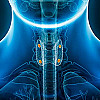Seasonal affective disorder
In the northern and southern regions of the world, winter means shorter days and longer nights. This seasonal shift, and the lack of sunlight that goes along with it, can trigger a type of depression known as seasonal affective disorder. People with seasonal affective disorder, sometimes known as the winter blues, begin to experience sadness, depression, and fatigue in the late fall; symptoms fade away in the spring.
Women tend to develop seasonal affective disorder more than men. The condition often begins in the third or fourth decade of life, though some children show signs of it.
Symptoms
Individuals with seasonal affective disorder experience some of these symptoms:
- feeling irritable
- difficulty concentrating
- sleeping more than usual
- increased hunger, possibly with craving for carbohydrate-rich foods
- weight gain
- more difficulty getting along with other people, or withdrawing from social interactions
- a leaden, heavy feeling in the arms and legs
Treating seasonal affective disorder
There are two main treatments for seasonal affective disorder: light therapy and antidepressants. It makes sense to start with light therapy first.
Light therapy
Light therapy is an effective way to treat seasonal affective disorder. One simple way to treat yourself with light therapy is to take a 30-minute every morning. Not only do you get extra light, but you also get some exercise, which can help ease symptoms of depression.
Light therapy can also come from sitting close to a special light box for 30 minutes, usually in the morning. The light is much brighter than that from indoor lighting. Proper light boxes provide 10,000 lux, a measure of light intensity. Indoor light is about 100 lux, while a bright sunny day is 50,000 lux or more.
Bright light acts on cells in the retina that connect to the hypothalamus, a part of the brain that helps control the body's daily rhythms (circadian rhythms). These rhythms are thought to be disrupted in seasonal affective disorder.
Successful treatment depends on carefully individualized timing and dosing of light. The light dose depends on the strength of the light source, your distance from it, the wavelength (color) of the light, and how long you sit in front of it. The recommendation for 30 minutes of daily exposure to 10,000 lux is based on average response to white light; some people may not need that much light, others may need more.
Traditional devices use white light, a mixture of all the colors (such as blue, green and red) in the visible light spectrum. The use of light-emitting diode technology has made it possible to create smaller and more portable devices, and to test specific wavelengths of light.
Ganglion cells in the retina are particularly sensitive to blue light, suggesting that this wavelength may powerfully affect circadian rhythms. Some research suggests that lower intensity blue light (750 lux) is as effective as bright, full-spectrum light (10,000 lux). If this evidence holds up, it may be easier to provide this light through general lighting fixtures. It may also reduce the risk of side effects or discomfort.
Light therapy improves symptoms of seasonal affective disorder in 50% to 80% of people who use it.
Possible side effects
Some people don't tolerate bright light. The biggest psychological risk is that bright light therapy may trigger hypomania or mania in people with bipolar disorder. Mood-stabilizing medications can be given to reduce that risk.
Bright light can cause retina damage, although that's rare. Some medications can increase the risk, including some antipsychotic medication, lithium, melatonin and St. John's wort. A few medical conditions can also increase risk: People with diabetes or pre-existing retina disease should discuss their conditions with their doctor before trying bright light therapy.
Antidepressants
Some people prefer not to walk outside in the morning, or sit in front of a light box, for 30 minutes a day. Others don't get much relief from light therapy. Antidepressants can also ease symptoms seasonal affective disorder. A selective serotonin reuptake inhibitor such as fluoxetine (Prozac), sertraline (Zoloft), and others is usually the first type to try.
Disclaimer:
As a service to our readers, Harvard Health Publishing provides access to our library of archived content. Please note the date of last review or update on all articles.
No content on this site, regardless of date, should ever be used as a substitute for direct medical advice from your doctor or other qualified clinician.















